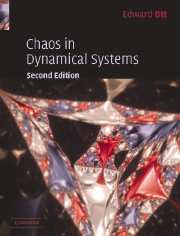Book contents
- Frontmatter
- Contents
- Preface to the first edition
- Preface to the second edition
- 1 Introduction and overview
- 2 One-dimensional maps
- 3 Strange attractors and fractal dimension
- 4 Dynamical properties of chaotic systems
- 5 Nonattracting chaotic sets
- 6 Quasiperiodicity
- 7 Chaos in Hamiltonian systems
- 8 Chaotic transitions
- 9 Multifractals
- 10 Control and synchronization of chaos
- 11 Quantum chaos
- References
- Index
3 - Strange attractors and fractal dimension
Published online by Cambridge University Press: 05 June 2012
- Frontmatter
- Contents
- Preface to the first edition
- Preface to the second edition
- 1 Introduction and overview
- 2 One-dimensional maps
- 3 Strange attractors and fractal dimension
- 4 Dynamical properties of chaotic systems
- 5 Nonattracting chaotic sets
- 6 Quasiperiodicity
- 7 Chaos in Hamiltonian systems
- 8 Chaotic transitions
- 9 Multifractals
- 10 Control and synchronization of chaos
- 11 Quantum chaos
- References
- Index
Summary
Perhaps the most basic aspect of a set is its dimension. In Figures 1.10(a) and (b) we have given two examples of attractors; one is a steady state of a flow represented by a single point in the phase space, while the other is a limit cycle, represented by a simple closed curve. While it is clear what the dimensions of these attracting sets are (zero for the point and one for the curve), it is also the case that invariant sets arising in dynamical systems (such as chaotic attractors) often have structure on arbitrarily fine scale, and the determination of the dimension of such sets is nontrivial. Also the frequency with which orbits visit different regions of a chaotic attractor can have its own arbitrarily fine scaled structure. In such cases the assignment of a dimension value gives a much needed quantitative characterization of the geometrical structure of a complicated object. Furthermore, experimental determination of a dimension value from data for an experimental dynamical process can provide information on the dimensionality of the phase space required of a mathematical dynamical system used to model the observations. These issues are the subjects of this chapter.
The box-counting dimension
The box-counting dimension (also called the ‘capacity’ of the set) provides a relatively simple and appealing way of assigning a dimension to a set in such a way that certain kinds of sets are assigned a dimension which is not an integer.
- Type
- Chapter
- Information
- Chaos in Dynamical Systems , pp. 71 - 114Publisher: Cambridge University PressPrint publication year: 2002



